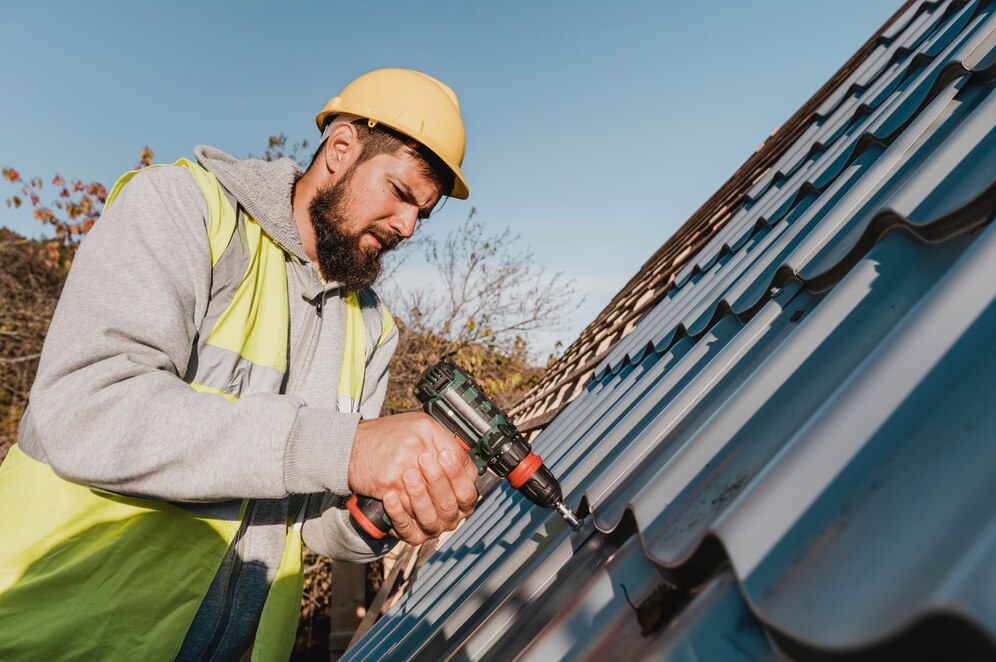Preparing your home for a roof replacement is an essential step to ensure a smooth and successful project. Whether you’re installing a new roof due to age, damage, or aesthetic reasons, proper preparation can minimize disruptions, protect your property, and help the roofing process proceed efficiently.
In this comprehensive guide, we’ll walk you through the steps involved in preparing your home for a roof replacement, from planning and organization to safety precautions and post-installation cleanup.

Hire a Reputable Roofing Contractor
Before beginning any home improvement preparations, contractor selection is crucial. Research local roofing companies, read reviews, and request quotes from multiple contractors to ensure you choose the best option for your project. Look for certifications, licenses, and insurance coverage to guarantee professionalism and accountability. Another tip for contractor selection is that a reliable one will provide detailed estimates, transparent communication, and warranties to guarantee satisfaction and peace of mind.
Obtain Necessary Permits
Depending on your location and the scope of the project, you may need to obtain permits or approvals from local authorities before starting the roof replacement. Your roofing contractor should be familiar with local regulations and can assist you in obtaining the necessary permits. Be sure to review any permit requirements, application procedures, and associated fees well in advance of the scheduled start date to avoid delays or complications. Proper permitting ensures that your roof replacement project complies with building codes and safety standards, protecting your investment and ensuring long-term performance.
Clear the Work Area
Clear the area around your home to provide unobstructed access for the roofing crew and their equipment. Remove vehicles, outdoor furniture, potted plants, and any other obstacles from the driveway, yard, and pathways leading to the house. Consider trimming overhanging branches or foliage that may interfere with the roofing process or pose safety hazards. Clearing the work area allows the roofing crew to work efficiently and minimizes the risk of damage to property or landscaping during the project.
Protect Your Property
Cover or relocate fragile items, such as outdoor furniture, grills, and decorative objects, to prevent damage from falling debris or construction materials. Consider covering landscaping, flower beds, and shrubs with tarps or plastic sheeting to protect them during the roof replacement process. Secure loose items, such as patio umbrellas, toys, and garden tools, to prevent them from becoming airborne or causing accidents during construction. Taking proactive measures to safeguard your property ensures that it remains intact and undamaged throughout the roof replacement project.
Secure Interior Belongings
While doing home improvement, take precautions to protect the interior of your home from dust, debris, and potential water leak and damage during the roof replacement. Cover furniture, electronics, and valuables with plastic sheeting or drop cloths, and remove any items from attic storage areas that could be affected by vibrations or disturbances. Consider sealing off attic access points or ventilation openings to prevent dust or debris from entering your home’s living spaces. Protecting interior belongings ensures that they remain clean, dry, and undamaged throughout the roof replacement process.
Plan for Noise and Disruption
Roof replacement projects can be noisy and disruptive, so it’s essential to prepare yourself and your family for potential inconveniences. Inform your neighbors about the upcoming work and apologize in advance for any noise or disruption it may cause. Consider making arrangements for pets, children, or elderly family members who may be sensitive to noise or disturbances during the project. If possible, plan to be away from home during the busiest days of construction to minimize disruptions and ensure safety.
Coordinate with Your Roofing Contractor
Maintain open communication with your roofing contractor throughout the preparation process to address any concerns or questions you may have. Confirm the start date, timeline, and expectations for the project, including work hours, crew size, and cleanup procedures. Discuss logistics such as access to electricity, water, and restroom facilities for the roofing crew, and provide any necessary instructions or restrictions for accessing your property. Clear communication and coordination with your contractor help ensure a smooth and successful roof replacement experience.
Prepare for Weather Contingencies
Be prepared for unexpected weather conditions that may affect the roof replacement schedule or progress. Monitor weather forecasts closely in the days leading up to the project and discuss contingency plans with your roofing contractor in case of rain, high winds, or extreme temperatures. Consider scheduling the roof replacement during a season with favorable weather conditions and flexibility for rescheduling if necessary. Having a plan in place for weather contingencies helps minimize delays and ensures the safety and efficiency of the roofing crew.
Arrange for Waste Disposal
Roof replacement generates a significant amount of waste materials, including old shingles, nails, and packaging materials, which need to be properly disposed of at the end of the project. Coordinate with your roofing contractor to arrange for waste disposal, either through a dumpster rental or hauling service. Ensure that the disposal method complies with local regulations and environmental guidelines for handling roofing materials. Clearing debris promptly keeps the work area safe and tidy and allows for efficient progress throughout the roof replacement process.
Plan for Post-Installation Inspections
Once the roof replacement is complete, schedule a post-installation roof inspection with your roofing contractor to ensure that the work meets your expectations and complies with industry standards. Conduct a thorough walkthrough of the property to inspect the new roof, flashing, vents, and gutters for quality, craftsmanship, and functionality. Address any concerns or deficiencies promptly with your contractor and request necessary repairs or adjustments as needed. A final roof inspection ensures that your new roof is installed correctly and provides lasting protection for your home.
Explore Financing Options
Roof replacement is a significant investment, so it’s essential to explore financing options that fit your budget. Consider personal loans, home equity lines of credit (HELOCs), or financing programs offered by contractors or manufacturers. Research lenders, compare rates, terms, and repayment plans to find the best option. With proper financing, you can proceed confidently with your roof replacement project while managing your budget effectively.
Conclusion
By following these steps and properly preparing your home for a roof replacement, you can help ensure a smooth and successful project from start to finish. Remember to communicate openly with your roofing contractor, address any concerns promptly, and prioritize safety throughout the process. With careful planning and preparation, you can enjoy the benefits of a new roof that enhances the comfort, protection, and value of your home for years to come.
Our experienced roofing contractors can walk you through the entire process, from inspection and permitting to finishing touches. We’ll work with your schedule to ensure minimal disruption.
Why choose us? As Maryland’s premier roofing company, we have the expertise to handle any job professionally and efficiently. Reviews show our dedication to quality work and customer satisfaction.
Call +1 (410)-999-5200 or email magnumhomeservs@gmail.com. We are ready to discuss your project and provide a free quote. Visit our website at www.magnumhomeservices.info to learn more. Count on Magnum for reliable roofing that protects your home for years to come.
FAQs
How long does it take to replace a roof?
The duration of a roof replacement project depends on various factors, including the size and complexity of the roof, weather conditions, and the efficiency of the roofing crew. Typically, a roof replacement can take anywhere from a few days to a couple of weeks to complete.
Will my homeowners’ insurance cover the cost of a roof replacement?
Whether your homeowners’ insurance covers the cost of a roof replacement depends on the cause of the damage and your policy’s coverage. Most insurance policies cover roof damage caused by unexpected events such as storms, fires, or vandalism. However, routine wear and tear may not be covered, so it’s essential to review your policy and consult with your insurance provider.
What should I do if I discover additional issues during the roof replacement process?
If additional issues are discovered during the roof replacement process, such as underlying damage or structural concerns, it’s crucial to address them promptly. Discuss any findings with your roofing contractor and consider their recommendations for repairs or upgrades to ensure the long-term integrity and performance of your new roof.
